
Any solid state drive provides a noticeable performance increase compared to a hard drive.
- Internal SSDinstalled instead of or in addition toexisting disks on your work computer. Such drives are cheaper and have potentially higher data transfer rates. But the options for upgrading laptops and PCs are often limited.
- Portable external SSDready to use out of the box and facilitate data exchange between different devices. Models with a capacity of more than 2 TB are rare.
In this guide, we'll take a look at the top performers in each category.
SSD rating:
- Best external SSDs for video editing
- Samsung T5
- Samsung T7 / T7 Touch
- SanDisk Extreme Portable V2
- ADATA SE800
- Best Internal SSDs for Video Editing
- Samsung 970 EVO Plus
- WD Black SN850
- Crucial MX500
- Adata XPG Gammix S50 Lite
- Samsung 860 PRO
- How to choose an SSD for video editing
Samsung T5
Compact, fast and reliable
Although the Samsung T5 is not based on the fastestSATA SSD, its performance is sufficient for direct recording of 4K video from the camera. The portable drive has a metal case that can withstand drops from a height of two meters.
Buy in M.Video
Buy in Svyaznoy
Buy on goods
Buy at KotoPhoto

optimal choice
</ img>
Samsung T7/T7 Touch
Bestseller update
Samsung T7 has almost doubled transfer speedsdata, but over “long distances” only the terabyte disk was able to surpass the previous model. We will recommend it for video editing. The Samsung T7 Touch variant also has a built-in fingerprint scanner - a useful feature if you plan to use encryption.
Buy in the Connected
Buy on goods
Buy at KotoPhoto
Samsung T7 Touch

alternative
</ img>
SanDisk Extreme Portable V2
Functional SSD in a rugged case
SanDisk Extreme Portable V2 is not afraid of either dust orrain, no splashes. Its rubberized body better withstands shocks and falls, but additional protection is not the only feature of the model. In our top, this is the most productive external SSD. We'll also add the non-boring design as a plus.
Buy on Amazon
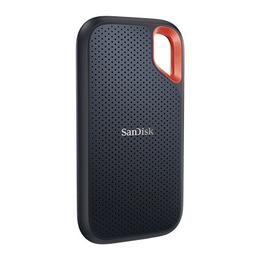
all-weather
</ img>
ADATA SE800
Miniature SSD with water protection
ADATA SE800 fits in the palm of your hand, showsgood read / write speeds and doesn't look like a toy. Despite the declared IP68 protection standard, this is more of a pleasant bonus than a selling chip. A simple plug, which can accidentally fly off, with the most dire consequences for the wearer, protects from the ingress of water inside.
Buy on Amazon
Buy at M.Video
Buy in Svyaznoy
Buy at Oldie
Buy at Techport
Buy on goods

small but smart
</ img>
Samsung 970 EVO Plus
High performance for a reasonable price
Samsung 970 EVO Plus is suitable for installation inlaptops and desktops. The drive has a peak write speed of 3300 MB / s and does not give in to any tasks. The company's software also makes it easy to clone an old drive.
Buy in the Connected
Buy at OLDI
Buy on goods
Buy at KotoPhoto
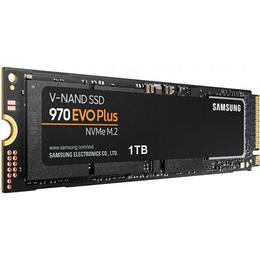
the best choice
</ img>
WD Black SN850
What you need to move to PCIe 4.0
WD Black SN850 Designed for PerformanceSSD for games, but it will be interesting not only for gamers. The new PCI Express 4.0 interface brings twice the bandwidth, resulting in sequential write speeds up to an impressive 5300 MB / s. The drive is also good at random small-block operations, and the efforts of Western Digital engineers were not in vain.
Buy in M.Video
Buy in Svyaznoy
Buy at KotoPhoto

the fastest
</ img>
Crucial MX500
Time-tested
The Crucial MX500 is a no-frills, reliable SSD.Thanks to its democratic price, the model has become a hit of sales, and the manufacturer also offers a choice between two popular form factors. Just a solid SATA drive.
Buy in the Connected
Buy at OLDI
Buy on goods
M.2 SSD 1 TB

affordable upgrade
</ img>
Adata XPG Gammix S50 Lite
Large volume for little money
Adata XPG Gammix S50 Lite - not the cheapestAn NVMe drive on the market, but due to its large write buffer, it is great for video editing tasks. Just don't count on the speed of top-end devices with PCIe 4.0 interface, in terms of performance, the model is not far behind PCIe 3.0 drives. At the moment, versions with a capacity of 1/2 TB are available for sale.
Buy at OLDI
Buy at Techport
Buy on goods
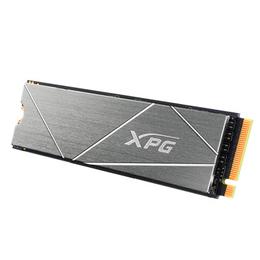
NVMe SSD for inexpensive
</ img>
Samsung 860 PRO
SATA SSD for heavy workloads
The 860 PRO uses a more robust 2-bitSamsung's own MLC memory. The drives of the series have a large recording resource. With active use, they will last several times longer than mass consumer models, but you will have to pay extra for reliability.
Buy in the Connected
Buy at OLDI
Buy at Techport
Buy at goods
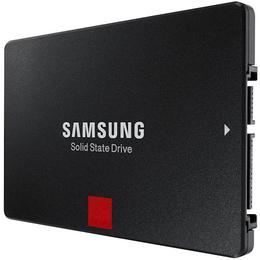
durable
</ img>
Best external SSDs for video editing
</ p>Samsung T5

</ img>
- Capacity: 500 GB, 1/2 TB; Features: drop protection
- Read/write speed: up to 540 / 520 MB/s;
- Interface / Protocol: USB-C / USB 3.2 Gen 2
Samsung T5 in a metal case is easyfits in your pocket. The portable SSD uses a fast USB Type-C connection and works when plugged into a regular USB-A port - both cables are included. The T5 demonstrates data transfer rates close to the stated 540/520 MB / s. Thanks to TurboWrite technology, when writing large files, performance remains at a consistently high level. Unlike the newer Samsung T7 Touch, which slows down when the write buffer runs out. Interestingly, the Samsung T5 can act as external storage for the Black Magic Pocket Cinema Camera 4K.
External SSD can withstand drops of up totwo meters. Hardware encryption is also supported. Initially, the Samsung T5 was available in four colors, today only the blue 500GB model and 1/2 TB variants in the black case are available for sale.
Read also:Samsung T5 external SSD review
3 reasons to buy:
- compact and lightweight
- stable performance
- robust and practical body
1 reason not to buy:
- NVMe SSDs offer faster speeds
Buy in M.Video
Buy in Svyaznoy
Buy on goods
Buy at Kotophoto
Samsung T7 / T7 Touch
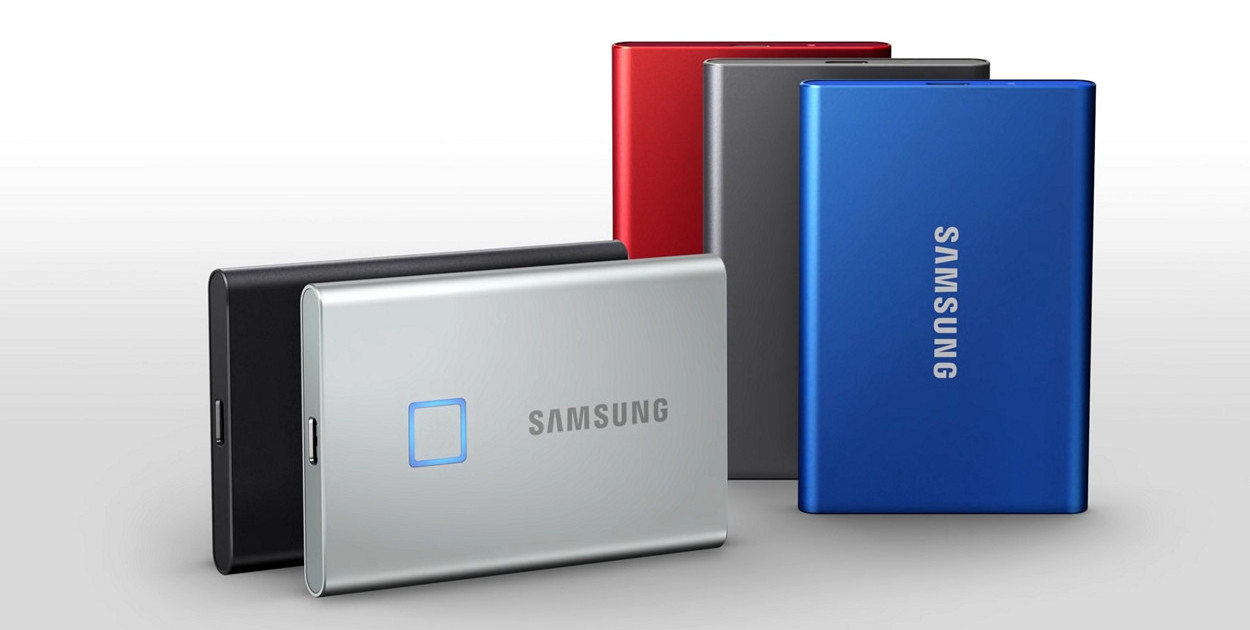
</ img>
- Capacity: 500GB, 1/2 TB Features: drop protection
- Read / write speed: up to 1050/1000 MB / s
- Interface / Protocol: USB-C / USB 3.2 Gen 2
Samsung T7 is a modification of the T7Touch without fingerprint scanner. The biometric sensor allows you to unlock access to encrypted data without entering a password, but if the user does not want to overpay for this function, he always has a choice. In terms of speed indicators, the models are identical. Compared to the T5, the drives are slightly longer and thinner. For video editing, terabyte options are better suited - in them, after filling the fast SLC cache, the speed decreases to 500-600 MB / s, while the versions for 500 GB and 2 TB, according to tests, give out less than 400 MB / s.
SSD drives also come with two cables,just over 40cm in length is enough to connect to the rear ports of a desktop PC. To protect data, 256-bit AES encryption is used, on the T7 Touch, using the Samsung Portable SSD utility, you can additionally save up to four fingerprints.
3 reasons to buy:
- thin metal body
- faster than models based on SATA SSD
- biometrics function in T7 Touch
1 reason not to buy:
- only one suitable container option
Buy in the Connected
Buy on goods
Buy at KotoPhoto
Samsung T7 Touch
SanDisk Extreme Portable V2

</ img>
- Capacity: 500GB, 1/2 TB Features: shockproof, IP55 protection
- Read/write speed: up to 1050 / 1000 MB/s;
- Interface / Protocol: USB-C / USB 3.2 Gen 2
The SanDisk Extreme Portable V2 has a ruggeddesign and offers excellent performance. In comparison with the first generation, read and write speeds have almost doubled to 1050 MB / s and 1000 MB / s, respectively. SanDisk also ditched 128-bit encryption in favor of the more secure AES-256 algorithm. Protection against dust and moisture according to the IP55 standard is declared - this SSD is not afraid of rain, splashes and dirt, but it is not designed for full immersion under water. The case with rubberized ends and bottom part withstands falls from a height of up to two meters. There is also a convenient attachment for a carabiner or a strap.
SanDisk Extreme Portable V2 has comparativelysmall write buffer (12 GB for the terabyte model), but no big drop in performance once it's full. When working with large files, the linear speed can be maintained at 820 MB/s.
3 reasons to buy:
- protection against dust, moisture and drops
- high speed of work with data
- confidently in the hand
1 reason not to buy:
- rubberized housing collects dust
Buy on Amazon
</ p>ADATA SE800

</ img>
- Capacity: 500 GB, 1/2 TB; Features: IP68 protection
- Write/read speed: up to 1000 / 1000 MB/s;
- Interface / Protocol: USB-C / USB 3.1 Gen 2
According to the manufacturer, the ADATA SE800 providesspeed up to 1000 MB / s. In practice, linear writing results in no more than 950 MB / s, with a rapid drop to 700-600 MB / s when the small write buffer is full. However, the drive is still faster than its SATA SSD competitors. The main feature is protection from dust and water according to the IP68 standard, SE800 will withstand a 30-minute immersion to a depth of 1.5 meters. You just need to make sure that the cap that covers the USB Type-C port fits snugly. Without this, moisture will easily get inside. The metal case looks expensive, plus you can not be afraid of accidental drops from the table.
ADATA SE800 is available in black and blue colors. The portable SSD is very compact and lightweight, making it easy to take with you everywhere.
3 reasons to buy:
- good combination of price and features
- IP68 protection standard
- takes up little space
1 reason not to buy:
- "Average" write speed
Buy on Amazon
Buy at M.Video
Buy in Svyaznoy
Buy at Oldie
Buy at Techport
Buy on goods
Best Internal SSDs for Video Editing
</ p>Samsung 970 EVO Plus

</ img>
- Capacity: 250/500 GB, 1/2 TB; Endurance: 1200 TBW
- Read / write speed: up to 3500/3300 MB / s; Warranty: 5 years
- Interface / protocol: PCIe 3.0 x4 / NVMe 1.3; Form Factor: M.2 2280
Samsung 970 EVO Plus - one of the first SSDscompanies that use 96-layer TLC 3D V-NAND memory. Versions with a capacity of 500 GB and higher provide write speeds close to the maximum for the PCIe 3.0 x4 interface. Of course, only within the SLC cache, the volume of which depends on the amount of free disk space (no more than 42 GB). When writing directly to TLC memory, the speed will be lower, but still at a good level - about 1.7 GB/s. Compared to previous Samsung models, heating under load has been reduced, and Dynamic Thermal Guard technology helps maintain optimal temperatures without sacrificing performance. Samsung Data Migration software allows you to transfer all data from your old drive; hardware encryption is supported using the AES-256 algorithm.
3 reasons to buy:
- fast and reliable
- supports hardware encryption
- useful software
1 reason not to buy:
- small write buffer when SSD is full
Buy in the Connected
Buy at OLDI
Buy on goods
Buy at KotoPhoto
WD Black SN850
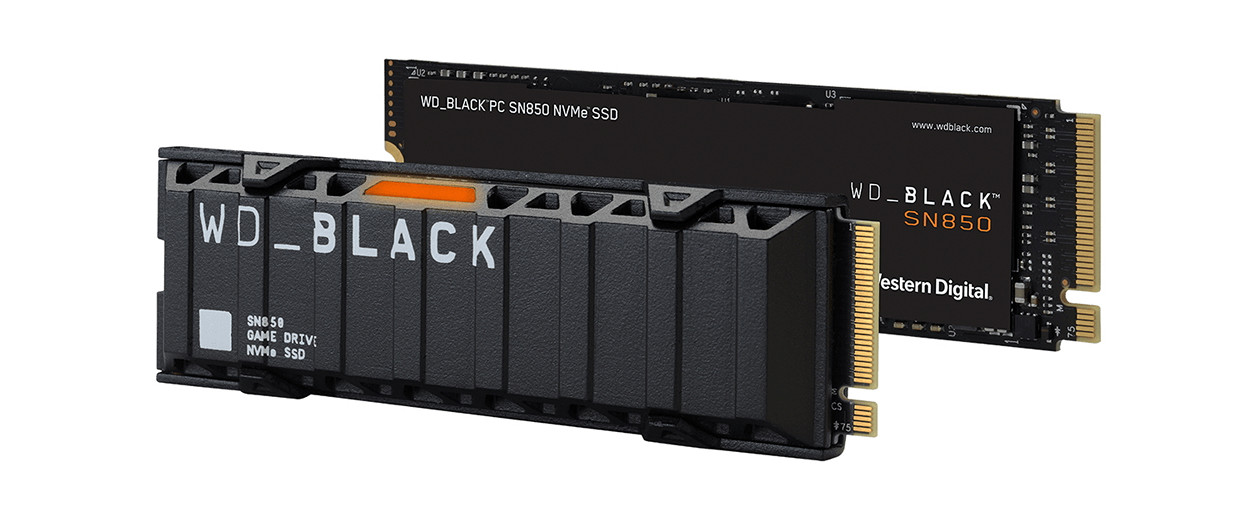
</ img>
- Capacity: 250/500 GB, 1/2 TB; Endurance: up to 1200 TBW
- Read / write speed: up to 7000/5300 MB / s; Warranty: 5 years
- Interface / protocol: PCIe 4.0 x4 / NVMe 1.4; Form Factor: M.2 2280
Western Digital's flagship should be of interestthose looking for a top performance SSD. The WD Black SN850 climbed to the PCIe 4.0 x4 bandwidth ceiling. The linear read speed reaches 7 GB / s. and up to 5.3 GB / s write (1 TB model). The NVMe drive is great for large files, and nCache 4.0 dynamic SLC caching technology can write almost a third of free space at high speed. The SN850 was designed with gamers in mind, so the company has added a dedicated game mode. When activated, all power saving features are disabled to reduce delays. The downside of this acceleration is the increased operating temperatures.
Possibility of installing additional coolingworth considering anyway. Under load, the SSD heats up a lot, and if the temperature of the controller exceeds 88 ° C, throttling is turned on. By the way, WD itself has released a version of the drive with a heatsink and RGB backlighting (it has not yet reached us). The proprietary WD Dashboard utility is available to customize operating modes, update firmware, and monitor performance in real time. Despite its "gaming" positioning, the WD Black SN850 is a great option for content creators. It can handle everything from video editing to 3D rendering.
3 reasons to buy:
- flagship performance
- unlocks the full potential of PCIe 4.0
- functional software
2 reasons not to buy:
- does not support hardware encryption
- you do not plan to switch to the new interface
Buy in M.Video
Buy in Svyaznoy
Buy at KotoPhoto
Crucial MX500

</ img>
- Capacity: 250/500 GB, 1/2 TB; Endurance: up to 700 TBW
- Read / write speed: up to 560/510 MB / s; Warranty: 5 years
- Interface/protocol: SATA 3 / AHCI; Form factor: 2.5″ / M.2 2280
The drive is available in two versionsversions: in a 2.5-inch case and in a more compact M.2 form factor. Crucial MX500 shows good performance for a SATA SSD, including thanks to dynamic buffer technology. In this series, the size of the SLC cache depends on the disk fill level. An empty model with a capacity of 500 GB can record up to 180 GB of data at high speed, but as the SSD is used, this volume can decrease several times. Then the speed drops, although not much - to 400 MB/s. For the younger 250 GB version this failure will be more significant.
Although the Crucial MX500 is not the highestrecording resource (40% lower than the aforementioned Samsung 970 EVO Plus), real tests confirm the high reliability of the drive. If someone is confused by this point, as an alternative, you can consider the Samsung 860 EVO with better wear resistance. However, it has already begun to disappear from sale.
3 reasons to buy:
- excellent value for money
- good performance for its class
- two form factors to choose from
1 reason not to buy:
- TBW is lower than some competitors
Buy in the Connected
Buy at OLDI
Buy on goods
M.2 SSD 1 TB
Adata XPG Gammix S50 Lite

</ img>
- Capacity: 1/2 TB; Endurance: 1480 TBW
- Read / write speed: up to 3900/3200 MB / s; Warranty: 5 years
- Interface/protocol: PCIe 4.0 x4 / NVMe 1.4; Form factor: M.2 2280
XPG Gammix S50 Lite is an affordable SSD withPCIe Gen 4 interface. And although the model will not provide a significant increase in performance relative to PCIe 3.0 speeds, the large write buffer makes it stand out from other entry-level NVMe drives. The disk can write 300-350 GB of data at a high speed of 3.2 GB/s. When performance drops, the performance becomes closer to SATA devices - up to 600 MB / s, however, this will only be noticeable on very large files. From the factory, the S50 Lite was equipped with a radiator, which reduced the temperature under load by 20%. An additional heat sink, on the one hand, will definitely not be superfluous, but it would be better if it were supplied separately in the box. The metal plate will most likely interfere with the installation of the motherboard's original heatsink, and it is not so easy to remove it. Problems may also arise when upgrading some laptops. The device supports a 256-bit AES encryption algorithm, and there is also proprietary diagnostic software.
3 reasons to buy:
- good speed performance
- large SLC cache
- radiator (unless you plan to remove it)
1 reason not to buy:
- Gets warm during intensive recording
Buy at OLDI
Buy at Techport
Buy on goods
Samsung 860 PRO
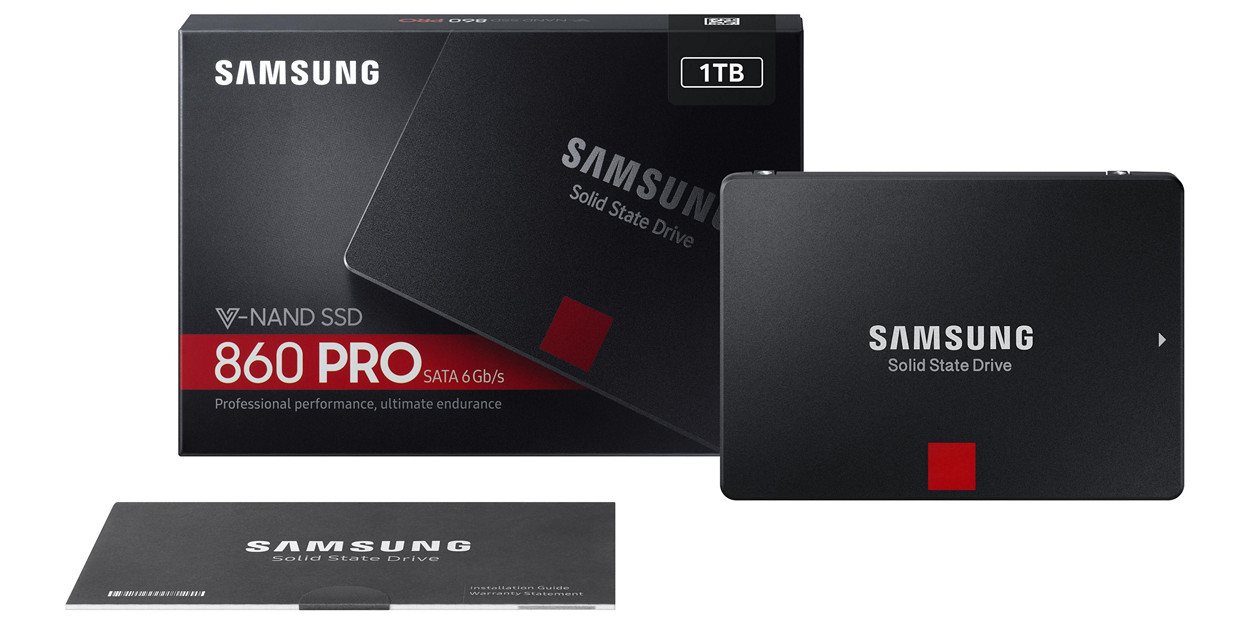
</ img>
- Capacity: 256/512 GB, 1/2/4 TB; Endurance: up to 4800 TBW
- Read / write speed: up to 560/530 MB / s; Warranty: 5 years
- Interface/protocol: SATA 3 / AHCI; Form factor: 2.5″
Samsung 860 PRO SSD is suitable for intensiveloads due to 2-bit MLC 3D V-NAND memory - its declared resource is several times higher than that of TLC. For example, the terabyte model can store 1.2 petabytes of data during the warranty period. The SATA interface limits the maximum speed at 530 MB / s, which is not much compared to NVMe devices. But performance does not drop when working with large files. The drive is available in a 2.5-inch case and can be installed in almost any PC. 860 PRO costs more than most consumer SSDs, and if endurance gain is not so important for the average user, in the case of professional video editing it is better to play it safe and pay more for your own peace of mind. Especially when it comes to 4K and higher resolutions.
2 reasons to buy:
- High write resource SSD
- Stable speeds throughout the tank
1 reason not to buy:
- Higher price per gigabyte
Buy in the Connected
Buy at OLDI
Buy at Techport
Buy at goods
How to choose an SSD for video editing
Any SSD will be faster than a hard drive, but getting the best fit for your system requires a little homework:
Check your device specifications
Internal SSDs use different hardware andsoftware interfaces. Check the specifications of your laptop and motherboard to determine which drives are compatible with your system. They can be produced in several sizes or form factors:
2.5″: such drives look like regular driveshard drive, and therefore can be installed in a standard 2.5-inch bay (and with a special adapter - in a 3.5-inch one). Such drives use the SATA (Serial ATA) interface, which provides data exchange speeds of no more than 600 MB/s.
M.2: Compact SSDs have become the standard for laptops,but M.2 slots can also be found on desktop motherboards. Drives of this type are only 22 mm wide and up to 110 mm long (the exact dimensions are indicated by a four- or five-digit code, for example, M.2 2280 or M.2 22110). They can support SATA or PCI Express/NVMe interface. In the second case, the maximum read and write speed is significantly higher.
Sometimes M.2 only accepts SATA or NVMe drives only. Both types can be supported, which is why you need to check the specifications of your PC or laptop before purchasing. If the necessary information is not on the manufacturer's website, you can always contact the support service or the official brand community for help.
Add-in Card (AIC)- this is an expansion board that connects toPCIe connector on the motherboard. Accordingly, this option should be considered only for desktop PCs. Due to the larger size, the AIC is easier to provide good heat dissipation to maintain high data transfer rates under long-term loads. Performance can also be increased by using all 8 or 16 lines of the PCI Express slot (for comparison, in M.2 there is a maximum of 4).
U.2: Devices in this form factor are slightly thicker than 2.5-inch SSDs. These are high-performance, high-capacity enterprise NVMe drives at a high cost.
When choosing an external SSDremember that modern devices withUSB 3.2 Gen 2 interface (also known as USB 3.1 Gen 2) delivers the stated speed when connected to the appropriate port. If your computer/hub only supports USB 3.2 Gen 1 or earlier, performance will be affected.
Another important point is that some drives withThunderbolt 3 interface does not work when connected to a “regular” USB-C port. If you do find a PC or laptop with Thunderbolt 3, such an SSD will be significantly faster than other models.
Memory types: SLC, MLC, TLC, QLC and how they differ
SSD uses flash memory, also knownlike NAND or 3D V-NAND if multiple layers of cells are stacked on top of each other. Each cell can store not one, but several bits at once (0 or 1). The more of them, the higher the density of information, but at the same time, the service life of the memory decreases. There are four main types in total:
SLC (Single-Level Cell).Only one bit of data is stored in each SLC cell.Maximum data transfer speed and high reliability, however, due to low density and high cost, manufacturers have switched to other technologies.
MLC (Multi-Layer Cell)The MLC cell stores two bits of information, the advantages are good endurance and relatively high speed.
TLC (Triple-Level Cell), same as3-bit MLCis the most common type of memory in modern SSDs.With its high density, it allows you to create relatively low-cost, high-capacity solutions.Manufacturers solve the lower speed compared to MLC in a variety of ways.One of them is the SLC cache, when a small area of memory is runningOnce the cache is full, performance decreases, although flagship NVMe drives remain fast even in TLC mode.
QLC (Quad-Level Cell)will result in an even more capacious and affordable SSD due toBut QLC speeds are lower on average, plus when large amounts of data are constantly recorded, as in video processing, the degradation of the drive will behappen faster.
Technologies are used to accelerate drivesSLC caching, when some part of the memory is running in fast pseudo-SLC mode. This buffer can be fixed or based on the amount of free space on the SSD. When it is filled, the performance decreases, sometimes quite noticeably. After finishing or pausing a write, the SLC cache is unloaded and speed is restored.
In SSDs, sequential write speed is important for video editing, since this type of operation accounts for the bulk of the load.
Endurance rating
Manufacturers usually indicate in the characteristicsparameter Total Bytes Written (TBW). This is the total amount of data in terabytes that can be written over the life of an SSD. Modern devices often exceed the declared resource, but if you choose a drive for video editing, it is better to focus on models with a high TBW. If you work with very large amounts of data, a Samsung 2-bit MLC drive or even a server model with a large write capacity may be the best choice.
Answers to popular questions
Internal or external SSD - which is better?
With a free slot / compartment available fordrive, an internal SSD may be the best choice (unless, of course, you risk losing your warranty). The most adequate in terms of price-performance ratio looks like Samsung 970 EVO Plus, however, there are more affordable options. If you have no time to expand storage, or you have to work on multiple devices, then you should look towards portable SSDs. There is also a third option: insert the internal media into a special case with your controller. True, not every such "pocket" is able to reveal the potential of the drive.
SSD speed is lower than advertised - what to do?
An SSD can be slow for a variety of reasons.Performance degrades when the drive fills up, and if you free up some space, the problem goes away. In some cases, unstable speeds are associated with an unsuccessful firmware implementation, which is solved by software updates. The maximum performance is often achieved due to the write buffer, after which the speed decreases. How critical is another question. Samsung Portable SSD T5, despite stable speeds, is limited by the bandwidth of the internal interface. SanDisk Extreme Portable V2 will be faster even during out-of-buffer recording.
SSD or HDD for video editing - which one to choose?
Upgrading from a hard drive to an SSD is virtually effortlessaffects the video processing time, but makes working on the project more comfortable. Loading the program itself and source files, exporting video and transferring files from the camera - all this will take less time. Especially when we are talking about top-segment devices like the Western Digital Black SN850. A fast solid-state drive can be used to store cache and preview files (and better as a separate, not system drive). An SSD will also provide smoother timeline performance and playback of multiple video streams without dropping frames. And a large HDD is suitable as a storage for projects.
To the list of devices ⤴